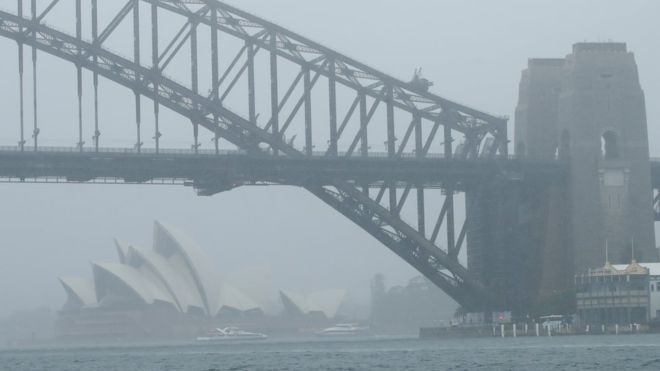
Australia fires: Heavy rain extinguishes third of blazes in NSW
- Torrential rain across the east coast of Australia has extinguished a third of the fires in the region - and could put more out, officials say.
Torrential rain across the east coast of Australia has extinguished a third of the fires in the region – and could put more out, officials say.
A wide band of rain sweeping New South Wales (NSW) has put out 20 of about 60 fires in the state in the past day.
Authorities have welcomed the downpour, but warned of flash flooding in Sydney and other cities along the coast.
Some of the affected areas had received the most rain recorded in over a year, said the Bureau of Meteorology.
Australia’s largest city, Sydney, recorded its wettest day in over 15 months on Friday. Many locals cheered on the downpour despite the inconvenience.
“It was fantastic to wake up to much-needed rain this morning!” tweeted the city’s lord mayor Clover Moore.
Much of NSW has been in drought for over three years, and such conditions have fuelled the intensity of the summer’s unprecedented fires.
Fire officials in NSW said they were “over the moon” to see the state’s forecast for a week-long drenching finally eventuate.
“This is that constant, steady, decent rainfall that we’ve been praying for for so long,” said NSW Rural Fire Service (NSWRFS) spokeswoman Angela Burford.
She told the BBC: “This isn’t just one of those scattered showers we saw a month ago. This is really helping our firefighters, and in some places, giving them a well-needed rest.”
However, Ms Burford warned that the largest blazes, in the state’s inland south and near the capital city of Canberra, had received limited showers so far and were still of concern.
The weather system hit south-east Queensland on Wednesday before moving south to affect neighbouring NSW.
Authorities have issued a severe wet weather warning for a 1,000km (621 miles) stretch of the state – with damaging winds, heavy rainfall, and “abnormally high” tides forecast.
Over 280mm of rain was recorded at the holiday town of Byron Bay in northern NSW. Locals there described the downburst on Thursday night as heavier than that experienced in a 2017 cyclone.
Rescue services said they had rescued a number of people trapped in cars amid rising water. There have been close to 1,000 calls for help in NSW and Queensland since Wednesday.
The heavy rains are predicted to continue until next week, providing relief to some drought and fire-ravaged zones. Some fires, which were finally contained this week, have been burning for over two months.
“This has been an absolute welcome disruption to the weather pattern and a massive reprieve and relief to so many people,” said NSWRFS Commissioner Shane Fitzsimmons on Friday.
He said while hotter and drier conditions would likely return in the coming weeks, this particular period of rain “is breaking the back of this fire season, no doubt”.
The state’s bushfire season, which began in September, could run until as late as April. Officials have also warned that the peak of fire danger is still to come for the southern states of Victoria and South Australia.
NSW has been the state most devastated in Australia’s bushfires crisis this year. The unprecedented scale and intensity of the blazes is a direct effect of climate change, scientists say.
Nationally, blazes have killed at least 33 people and destroyed thousands of homes. More than 11 million hectares of land – an area comparable to the size of England – has been scorched.



